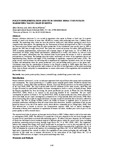| dc.contributor.author | Kasina, Muo | |
| dc.contributor.author | Nderitu, John Huria | |
| dc.date.accessioned | 2013-06-29T14:23:19Z | |
| dc.date.available | 2013-06-29T14:23:19Z | |
| dc.date.issued | 29-06-13 | |
| dc.identifier.uri | http://hdl.handle.net/11295/42681 | |
| dc.description.abstract | Potatoes (Solanum tuberosum L.) are second in importance after maize in Kenya as food crop. It is grown
mainly by small scale farmers in more than 100,000 ha country wide producing more than 1 million tonnes
annually. The marketing value chain has been described as ineffective, with farmers getting far much lesser
compared with other players. Recognizing this, the Government of Kenya developed laws in 2005 to streamline
the chain and ensure farmers gain from the potato production. It also established some specific laws in 2008 to
interpret the 2005 laws in target chain levels. This study was carried out between December 2009 and February
2010 to monitor implementation, enforcement and economic impact of legal notice no. 113 of 2008 of the
Government of Kenya using formal questionnaires administered to traders and farmers in selected seven
markets and regions. Information was also obtained from focused group discussions as well as stakeholder
participation in a workshop. The findings show that traders and farmers are aware of the regulations but are not
implementing them. Farmers had higher (97%) knowledge of regulations compared with traders (92%). The
major reasons cited by farmers for not being able to implement the regulations included cartels, lack of storage
facilities and information about the potato production costs and prevailing market prices at any given time.
Calculations show that the contribution of potatoes to the Kenyan economy is 300% higher than what is in
government records. This study provides more evidence of the effect of the legal notice on the potato marketing
value chain in Kenya and policy recommendations to ensure enforcement of the regulations and streamline the
potato value chain. | en |
| dc.description.abstract | Field experiments were conducted over two cropping seasons to investigate the effectiveness of
border crops in managing potato aphids and the associated viruses in seed potato production.
Potato plots were surrounded with maize, sorghum and wheat borders. Aphid population was
monitored on leaves and on yellow sticky traps. Other data collected included virus disease
incidence and tuber yield. The border crops reduced aphid population on leaves compared to
non-bordered potato plots. More alate aphids were caught on yellow sticky traps placed inside
potato plots than on traps placed inside the border crops. In addition, virus disease incidence was
reduced in all plots surrounded by the border crops. However, plots surrounded by border crops
had reduced tuber yield, although the yield of seed grade was increased. The results indicated
that use of border crops would be beneficial in the management of virus diseases in small-holder
seed potato production | |
| dc.language.iso | en | en |
| dc.title | Policy Implementation And Its Economic Impact On Potato Marketing Value Chain In Kenya | en |
| dc.type | Working Paper | en |

